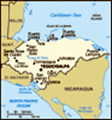Advertisement
Published: February 22nd 2010
A pleasant mile walk to the ruins on a lovely paved sidewalk. Guides were perched outside their hut. One approached us, talking about the tours available. We asked “Do you know Juan Carlos?”
“No, I don’t.” We paused, not sure what to do. “Oh, well, yes actually, he’s my cousin.” In these towns everybody is everybody’s cousin. We said, “He was recommended. Is he here?” He answered, “No, he isn’t here now.” Which was technically true, if he meant that Juan wasn’t actually standing here in front of us. Actually, Juan was there inside the hut twenty feet away. Eventually, we got Juan and glad we did. He was born in Copan and had been a guide for twenty years. His photo was in my souvenir guidebook.
Copan Ruins
The ruins were more cool than I expected. Even though it was the southern most outpost of the Mayan civilization, it was the cultural and intellectual center of the Classic Period. We climbed Temple 11, the portal to the other world, where the king talked with the Gods. I expect he reported that the Gods told him to collect more taxes.
Next we
came to the Ball Court, considered the social center of the city. This park is the second largest and by far the most artistic ball court in Meso-America. Like volleyball, the aim is to keep the ball in play but this ball was made of solid rubber and weighed up to nine pounds(!). One side or person won when the ball hit above the slanted portion of the court. In the most widespread version of the game, the players struck the ball with their hips, although some versions allowed the use of forearms, rackets, bats, or handstones. Sometimes the loser(s) were sacrificed, and sometimes the winner(s) were sacrificed. Did players know which before the game? See photo of sacrificial altar for beheading and the spiral groove where blood would drain.
Nearby is the Hieroglyphic Stairway — a staircase now three stories tall, and originally six stories, where 63 steps and several thousand glyphs tell the history of the royal house of Copan, at least in the elite’s opinion. The longest known text of ancient Mayan civilization and the largest stone library in the world. The higher altitude photos were taken from the acropolis for astrological observation. They accurately predicted
solar and lunar eclipses, useful for farming and cultural control. They made significant discoveries in science, including the use of the zero in mathematics. Their writing was the only one in the Americas capable of expressing all types of thought.
The Mayan Calendar
All cultures locate themselves in space and time. Mayans seem to me to be extreme in locating themselves a very long time, and a very great space. “Culture” was not primarily social or technological, was primarily cosmic (astronomical and mathematical), then ecological (living the jungle), then social. The use of the wheel was reserved for calendars, never used practically, for transportation. They had a wheel for each of three calendars. One revolution for the year, and the “long” calendar of 512 years. The three calendars all coincide in our year 2012 AD, the end of the world says a new Hollywood release, and just the start of a new cycle says Mayans
.
I was less interested in when the long cycle ends than when it begins, 3113 BC. All cultures begin their calendar in with some significant date. For the ancient Greeks it was the first Olympic Games, for the Romans
it was the founding of Rome, for Christians, the birth of Christ; for Moslems, the Hegira (the flight of Mohammed to Medina). What event could have happened in 3113 BC?
Perhaps another mile down the road was the neighborhoods where the elites lived. See photos of their small stone “houses,” I suppose huge to the slaves who built them, but really just a place to sleep and to store a handful of belongings in a lovely setting.
What seemed like a long walk back to town made Twisted Tania’s a little sweeter. The girls chatted away, comparing their experiences with NGO’s. Halfway through the second round Maureen turned toward me, “So tell me, father” —my ears twitched—“in one or two sentences”—italics in the original—“from your experience, what advice would you give us?” Maureen asks questions like this regularly, like once every six years. I replied, “Well, my advice is just to keep doing what you’re doing: taking risks and learning from experience.”
Walking back through the main plaza we found a packed audience, enjoying the celebration of, we think, a recent mayoral election. The variety show was high energy and sweet: an announcer on stilts, one
guy lip synching and dancing Michael Jackson hits, a corny farmer slapstick comedian, and hot chicks singing…hey, Maureen, what genre were they singing?
Advertisement
Tot: 0.098s; Tpl: 0.021s; cc: 10; qc: 28; dbt: 0.0434s; 1; m:domysql w:travelblog (10.17.0.13); sld: 1;
; mem: 1.1mb





















anonymous
non-member comment
Still reading and enjoying.